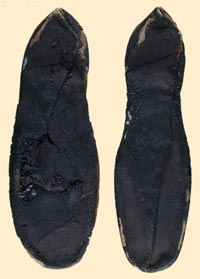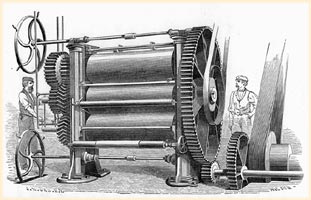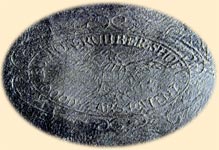
An 1866 biography of Goodyear describes factory production of this miraculous new product:
The India-rubber shoe, as we now have it, is an admirable article, light, strong, elegant in shape, with a fibrous sole that does not readily wear, cut, or slip. As the shoe is made and joined before vulcanization, a girl can make twenty-five pairs in a day. They are cut from the soft sheets of gum, and joined by a slight pressure of the hand... A million and a half pairs per annum is now the average number made in the United States by this process. (PEIRCE 136)
Rubber Goodyear overshoes attributed to Abraham Lincoln (CHS 1920.683).
Chicago Tribune ad for vulcanized elastic skirts, April 17, 1865. "Calenders heated internally by Steam, for spreading India Rubber into Sheets or upon Cloth, called the 'Chaffee Machine,'" Trials of an Inventory: Life and Discoveries of Charles Goodyear, Bradford K. Peirce, 1866. Courtesy of Northwestern University Library.
Material analysis will not provide a firm date for the comb as hard rubber combs are still produced today.
The comb is embossed "Patent I.R.C.CO;" a patent search is pending.
Goodyear seal on overshoes attributed to Abraham Lincoln (CHS 1920.683).





Some of our readers have been out on the picket line during the war. They know what it is to stand motionless in a wet and miry rifle-pit, in the chilling rain of a southern winter's night. Protected by India rubber boots, blanket, and cap, the picket man performs in comparative comfort a duty which, without that protection, would make him a cowering and shivering wretch, and plant in his bones a latent rheumatism to be the torment of his old age. (PEIRCE)
